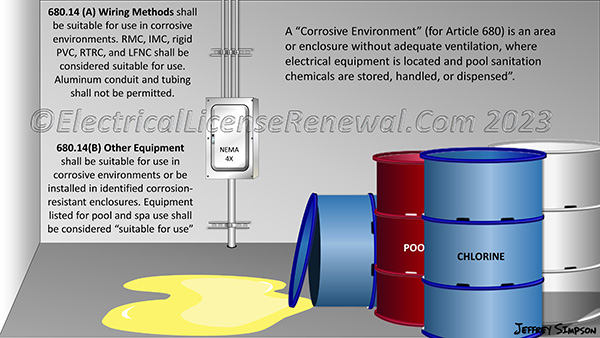680.14 Corrosive Environments.

Code Change Summary: Revised code language regarding wiring methods and equipment in corrosive environments.
Article 100 defines a “Corrosive Environment” (for Article 680) as “areas or enclosures without adequate ventilation, where electrical equipment is located and pool sanitation chemicals are stored, handled, or dispensed”.
In the 2020 NEC®, Section 680.14 applied strictly to wiring methods in corrosive environments for installations within the scope of Article 680.
In the 2023 NEC®, Section 680.14 was divided into a list to incorporate new requirements covering “other equipment”. This resulted in rewording the heading of the section to “Corrosive Environments”.
Additionally, the previous requirement for all wiring methods installed in a corrosive environment to be “listed and identified for use in such areas” was deleted. Now, wiring methods installed in a corrosive environment shall be “suitable for use” in corrosive environments.
Currently there are no wiring methods “listed and identified” specifically for corrosive environments in and around pools or similar installations covered in Article 680. There are several wiring methods in NEC® Chapter 3 that meet the intent of the previous language although they are not specifically “listed and identified” for the corrosive environments common to Article 680. NEC® Section 300.6 provides language on protecting against corrosion and deterioration. See also Section 110.11.
To keep the previous requirement for wiring methods installed in a corrosive environment to be “listed and identified” for use in such areas would require the development of additional product safety standards.
New Section 680.14(B) requires other equipment to be suitable for use in corrosive environments or be installed in identified corrosion-resistant enclosures. Equipment listed for pool and spa use is considered “suitable for use”.
NEC Table 110.28 provides information on the suitability of different enclosure types. A NEMA 4X enclosure for example is suitable for corrosive agents.
Below is a preview of the NEC®. See the actual NEC® text at NFPA.ORG for the complete code section. Once there, click on their link to free access to the 2023 NEC® edition of NFPA 70.
2020 Code Language:
680.14 Wiring Methods in Corrosive Environment. Wiring methods in a corrosive environment shall be listed and identified for use in such areas. Rigid metal conduit, intermediate metal conduit, rigid polyvinyl chloride conduit, and reinforced thermosetting resin conduit shall be considered to be resistant to the corrosive environment.
2023 Code Language:
680.14 Corrosive Environments.
N (A) Wiring Methods. Wiring methods shall be suitable for use in corrosive environments. Rigid metal conduit, intermediate metal conduit, rigid polyvinyl chloride conduit, reinforced thermosetting resin conduit, and liquidtight flexible nonmetallic conduit shall be considered suitable for use. Aluminum conduit and tubing shall not be permitted.
N (B) Other Equipment. Other equipment shall be suitable for use in corrosive environments or be installed in identified corrosion-resistant enclosures. Equipment listed for pool and spa use shall be considered suitable for use.